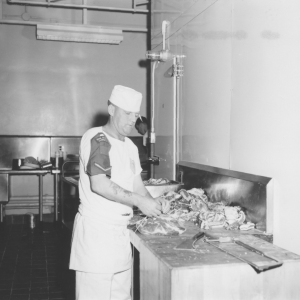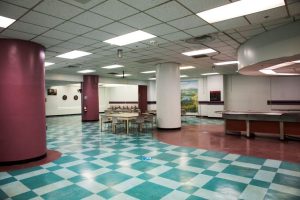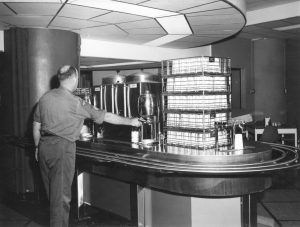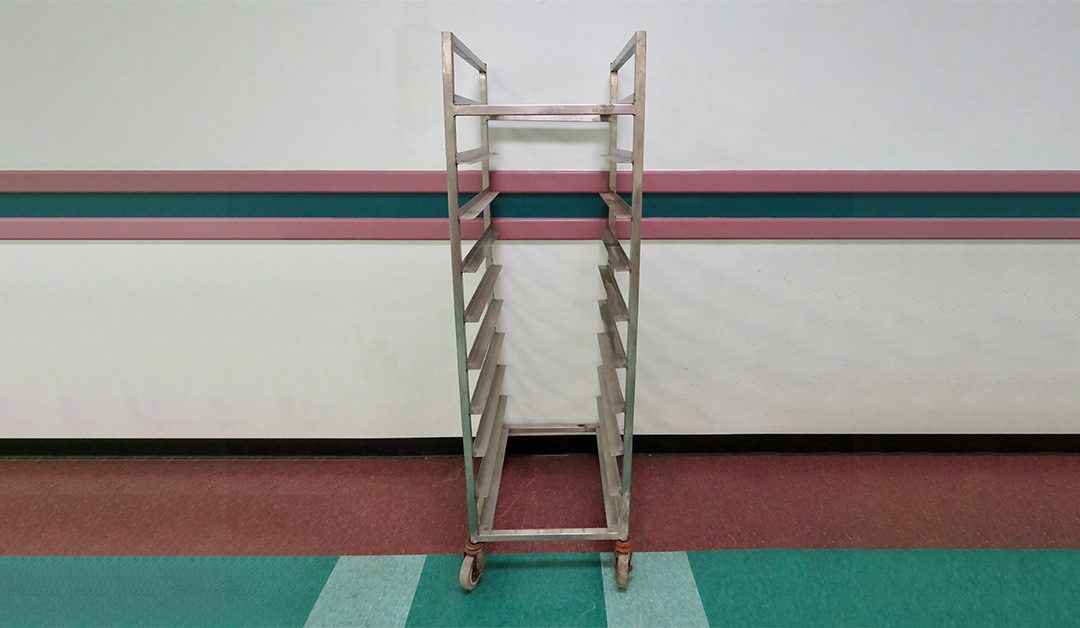(14/25)
In honour of our 25th anniversary, we are highlighting 25 artifacts from within our collections, and with Thanksgiving right around the corner, we decided to delve into the world of food and feature a baker’s rack from the Diefenbunker’s Cafeteria for this week’s artifact highlight.
During the Diefenbunker’s operation as Canadian Forces Station (CFS) Carp between 1961 and 1994, the Cafeteria, designed to be a space for recreation and relaxation, was the bustling social centre of the facility. The Cafeteria was open on a 24-hour basis, seven days a week, and continuously served four meals daily throughout its thirty-two years as an active military base. At any given time during the Cold War, the Cafeteria was prepared to feed the 500 to 600 designated government officials, military personnel, and civilians who would have been stationed in the bunker for 30-day lockdown if a nuclear attack on Canada was detected. Given this, the Cafeteria’s supply of fresh food was replenished every seven days.

The Diefenbunker Museum Archives
One of the cooks who worked at CFS Carp between 1966 and 1976, known to others as “Pub,” explained that working here in the kitchen was a full-time operation. There was a staff of 100 to 150 people, eight to ten of whom were cooks, on a 24-hour shift rotation. Pub explained that there were around six cooks working the day shift, another cook in the evening, and a night cook. An evening cook would start their shift around four o’clock in the afternoon and work up until midnight, then a night cook would start their shift at midnight and work until eight o’clock in the morning. As a result, food was served around the clock, ensuring that everyone, regardless of their shift schedule, had meals provided for them every three to four hours.
This baker’s rack from the Diefenbunker’s collections is a rectangular, mobile cart with casters at the base. Constructed of silver metal, this baker’s rack would have allowed cooks to access sheet trays, provided them with storage for food on these trays, and eased the transportation of food from one end of the Cafeteria to the other.
Originating from 17th century France, baker’s racks have a rich history and were used by bakers who needed a place to cool their freshly baked bread. These racks were originally made of wrought iron and had wire shelves, but they began to change in appearance and functionality after gaining popularity in North America in the 19th century. Still being used as a place to store food, baker’s racks were now also being used to store pots, pans, and sheet trays.
 The Diefenbunker’s Cafeteria is the largest room in the facility and was designed in such a way that it was divided into three areas: the recreation area, the eating area, and the kitchen area. The eating area was further divided into three sections: a separate room for Senior Officers, a curtained–off area for Non-Commissioned Officers, and the remaining space for lower ranks. Despite this separation, morale in the Cafeteria remained high and mealtimes provided an opportunity for socialization.
The Diefenbunker’s Cafeteria is the largest room in the facility and was designed in such a way that it was divided into three areas: the recreation area, the eating area, and the kitchen area. The eating area was further divided into three sections: a separate room for Senior Officers, a curtained–off area for Non-Commissioned Officers, and the remaining space for lower ranks. Despite this separation, morale in the Cafeteria remained high and mealtimes provided an opportunity for socialization.

The Diefenbunker Museum Archives
When CFS Carp closed in 1994, smaller kitchen items and stoves were removed in preparation for the site to be sealed. Larger items such as the freezers, the servery, sinks, and cabinetry were left as they were too difficult to remove. The Cafeteria was the most popular room in the bunker, not only because of its large, open feel, but also because the food served in the Cafeteria is reputed to have been some of the best food of any Canadian Forces base. Many former employees list the high quality of food as being one of the main reasons that their posting at CFS Carp was so enjoyable.
Learn more about what it was like working as a cook in the Diefenbunker, 75 feet underground, by listening to “Pub’s” oral history here:
Stay tuned as we continue to celebrate our 25th anniversary by uncovering stories from our museum’s collections.
